Muscle Pain in Middle Back
When you feel sharp or stabbing pain below the neck and above the bottom of the rib cage, it is suggested to be muscle pain in the middle back.
You also feel stiffness or tightness in the muscle.
This muscle pain is produced due to many causes like sprain and strain in a muscle, & damage in the muscle.
This muscle pain is especially relieved by to RICE principle, pain medication, and physiotherapy treatment.
Which area of the back is considered your middle back?
Your middle back is contained in the thoracic spine which consists of 12 vertebrae.
These all vertebrae are attached to the ribs and represent the rib cage region between the neck and the diaphragm.
Thoracic Erector Spinae group muscles are near the thoracic spine, in the thoracic Erector Spinae group, muscles contain the Iliocostalis, Longissimus, and Spinalis-the primary extensor-backward twisting muscle of the thoracic spine which is situated on either side of the vertebral column.
The erector spine muscle is most massive in the lumbar and thoracic areas.
Causes of middle back muscle pain
Obesity:
Weight and lower back pain are a positive correlation between obesity and back pain, so When your weight gains, the dangers of middle back pain.
Poor posture:
If your posture is used repeated pressure on the spine leads to middle back muscle pain.
Because the muscles & ligaments in your back work hard to maintain your level when you slouch overworking these muscles which are lead to aches & middle back pain.
Fall or another damage:
This middle back muscle is less experience harm than the cervical spine and lumbar spine.
Muscle sprain or strain:
Sprains mean the stretching and tearing of ligaments.
Strains mean the over-stretching and tearing of tendons or muscles.
When you are regularly carrying heavy things, but without the proper form, it causes a sprain or strain of the middle back.
Sprains and strains also appear after an awkward and impulsive movement.
These injuries include:
- A car accident
- A hard fall like from a height or down the stairs
- Sports accident
- A thoracic spine injury occurs to anyone, but older people are at a higher chance.
- Blunt force trauma
- When you experience middle back pain after the incident so that contact your doctor instantly.
Herniated disk:
A herniated disk happens when the internal gel-like core of a disk in your middle back pushes against the outer ring of cartilage, which is used to putting stress on a nerve.
This condition is generally called slipped disks or ruptured disks (Intervertebral disc prolapse).
This pressure is produced nerve pain, numbness, and tingling in the middle back muscle which also radiates to the nerve in the legs.
Osteoarthritis:
Osteoarthritis ( OA ) is a degenerative joint disorder that arises when the cartilage covering your joints breaks down, which leads to bones rubbing together.
Aging:
More geriatric people are more experience with middle back pain, this middle back pain mostly happens in 30 – 50-year-olds.
Some age-related procedure which is naturally worn on the body, involves thinning bones, a reduction of fluid between joints in the spine, and a reduction in muscle mass all things are produced in middle back pain.
Fractures:
Vertebrae fractures often happen due to trauma like a fall, car accident, and sports injury.
These fractures also happen in people with decreased bone density like people with OA.
Fractures are produced painful middle back muscle pain which is become more harmful during the activity.
Due to the fracture, you are also experiencing incontinence, tingling, and numbness this fracture is sometimes affecting the spinal cord.
Kidney problems:
Some kidney issues produce pain in the middle back which stays beneath the rib cage on either side of the spine.
Lifestyle factors:
When you do not exercise every day it causes weak muscles, which is contributing to pain.
If you do inappropriate lifting it cause middle back muscle pain.
Osteoporosis:
Osteoporosis this disorder is a type of bone infection which is given to results in breakable bones.
It happens when the body does not make sufficiently new bone to replace the natural bone loss.
Mental health conditions:
When you are experiencing depression and anxiety it tends to enhance the risk of developing middle back muscle pain.
Scoliosis:
Scoliosis means the spine curve becomes sidewards which causes the irregular distribution of weight throughout the back and produces middle back pain.
Tumor:
If occur to a tumor is growing in the middle back, it may concern the spinal alignment which is used to pressure the near nerves, muscles, and ligaments.
Symptoms of middle back muscle pain
- You feel many different symptoms of middle back pain.
- Your symptoms rely on the cause of your muscle pain.
- You feel a dull type of pain and muscle aches
- You also feel stabbing pain and are too sharp.
- This kind of pain is sometimes a burning sensation
- You are feeling stiffness and tightness in the muscle.
- Sometimes you feel numbness and tingling in the arms, legs, or chest.
- Also feeling of weakness in my arms and legs.
- Sometimes loss of power of the bowel or bladder.
- You feel trigger and tender points in the muscle pain.
- You are observed swellings and spasms around the muscle.
Diagnosis of middle back muscle pain
You must be contacted your doctor when the symptoms become too painful so that follow the diagnosis to try to know the reasons for the middle back pain.
The doctor is using the following stages for diagnosis:
Physical exam:
During the physical exam, the doctor monitors your spine, head, abdomen, pelvis, arms, and legs.
When occurring in an accident as an emergency responder you put a collar near your neck during the reexamination to stabilize the spine.
Testing:
Your doctor is recommended to do some examinations which are useful to diagnose these tests including neurological and imaging tests.
A neurological test studies the function of the brain and spinal cord.
During the test, the doctor is to twitch toes and fingers.
This test shows the status of the spinal cord and nerve endings.
Imaging tests are produced to pictures of the interior of the body.
These tests show fractures, bone degeneration, and other causes of middle back muscle pain.
The tests include:
- MRI scan
- CT scan
- X-ray
- ultrasound
- These imaging tests allow your body to any injury to your spine and specify a proper course of treatment.
Treatment for middle back muscle pain
RICE principle for middle back muscle pain
When feels pain in the middle back muscle direct contact with the doctor and he/she suggested the RICE principle as home treatment or primary treatment.
Rest( R ): When you feel muscle pain suggestion to rest and sometimes form movements that reduce to muscle pain.
Ice ( I ): You are used to ice on the site of the pain for 10 minutes, release to swellings and muscle pain but always used to the ice with the help of a towel between the skin and ice to eliminate ice burn, you can also be utilized to an ice pack and frozen peas for ice therapy.
Compression ( C ): You can also use compression bandages reduce to muscle pain and swelling.
Elevation ( E ): When you feel pain middle back you must be used to the pillow under the leg to reduce the swellings and also take care in the sleeping position.
Medical treatment for middle back muscle pain
In some circumstances of pain, the doctor specifies anti-inflammatory and muscle relaxant medicines.
When a doctor suspects this muscle pain is due to depression then he/she is suggested an anti-depressant medication but not take it for a long time.
An opioid is recommended for extreme pain but this medicine is also not advised for a long time ( 7-10 days ).
You can also use pain-relieving spray and gel-like volini gel and spray on the site of muscle pain to remove muscle pain and swelling.
Physiotherapy treatment for middle back muscle pain
When the muscle pain is not reduced after the home treatment and pain medicine then the doctor has recommended physiotherapy treatment to dismiss muscle pain.
Physiotherapy treatment is support to reduce pain, spasms and swelling, and tightness of the muscle pain.
The physiotherapy treatment involves massage, electrotherapy treatment, and exercise therapy.
Massage:
When the tender points and trigger points are present in the muscle pain site physiotherapist is suggested to massage therapy discharge to the muscle pain.
Massage is used after 2 to 3 days of following the RICE principle when you feel relieved from the pain.
Massage is used with the help of the oil and applied for 5 to 10 minutes.
Massage is applied 3 times/day at home.
Electrotherapy treatment:
After the follow the RICE principle, pain medicine, and massage therapy, if the muscle pain is not relieved then applied Electrotherapy treatment for the release of muscle pain.
To reduce the swellings, spasms, and pain physiotherapist is suggested to use electrotherapy treatment.
In electrotherapy, the therapist is used to many apparatuses.
Ultrasound ( US ): When the tender points and trigger points are present physiotherapists are suggested to apply ultrasound therapy for the reduction of muscle pain.
This therapy is applied with the help of gel and given for 5-10 minutes in the place of pain.
This therapy helps you remove pain and swelling.
Also, for relief, the therapist has used Short wave diathermy ( SWD ), Interferential Therapy ( IFT ), and Transcutaneous Electrical Nerve Stimulation ( TENS ) at the site of pain.
Short wave diathermy ( SWD ): Short wave diathermy is hot therapy for release to spams on the area of pain.
Interferential Therapy ( IFT ) and Transcutaneous Electrical Nerve Stimulation ( TENS ) are applied with the help of gel and electrodes on the site of pain.
This treatment is used for 10 minutes at the location of the pain.
Exercise therapy for middle back muscles pain
After following the RICE principle for 2 to 3 days at home and primary treatment and the help of pain medicine, you feel removed from the pain.
When you feel too relaxed and released from your muscle pain then the therapist is recommended to you exercise therapy reduce to muscle weakness and tightness.
Exercise therapy for muscle pain involves strengthening and stretching exercises.
Strengthening exercises help you relieve muscle weakness as well stretching exercise helps to relieve muscle tightness.
Strengthening Exercises:
After the follow of Electrotherapy and massage for 2 to 3 days to remove neck muscle pain by the therapist then the therapist is instructed to do strengthening exercises for neck muscle weakness.
This strengthening exercise is always recommended when you feel to remove pain and when you feel relaxed.
This all-strengthening exercise benefits you with muscle pain and weakness:
- Bridge Pose
- Passive backend
- Resistance band pulls
- Opposite arm/leg raise:
- Dumbbell row
Bridge Pose:
The patient’s position is in lying on your back then flex your knees and place your feet flat on the ground a few inches away from your tailbone.
After that, your fingers can touch your heels.
Press your shoulder joint into the ground and gently tuck them further to your middle back so that your chest puffs out just forward.
Push into your feet and send your hip joint up to the sky, then hold your hands under you, pushing into your arms and feet to lift your hips gently toward the roof.
Bring awareness to your middle back behind your heart place and consciously send your chest toward the wall behind you.
This posture helps to bring the backbend out of the middle back.
Maintain for 10 seconds before slowly lowering down or unclasping the hands and bringing them to rest at your side.
Repeat this exercise and perform 10 times in 1 session and perform 3 sessions/day.

Passive backend:
The patient’s position is to place the roll on the ground.
Then lying on the roll so that it is rest under the shoulder blades, near the middle of the back.
Try to put something under your head if needs elevation, then start with arms away from the body and resting at a 45-degree angle.
Maintain this position for 1-2 minutes.
Repeat this exercise and perform 10 times in 1 session and perform 3 sessions /day.
Resistance band pulls:
The patient’s position is standing with feet parallel and hip-distance apart, then holding a resistance band and raising your arms out in front of you at shoulder joint height.
Must hold your navel engaged and stand tall.
Try to squeeze the shoulder blades together as the hands separate and gradually release them back to the middle.
Maintain the exercise for 10 seconds.
Repeat this exercise and perform 10 times in 1 session and perform 3 sessions /day.
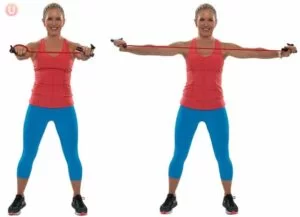
Opposite arm/leg raise:
The patient’s position is on your hands & knee joints must keep your spine straight, with your hands directly below your shoulder joint and your knees aligned directly beneath your hips.
Try to gradually reach out with one arm while expanding the leg on the opposite side.
Must be held at both straight levels.

Dumbbell row:
This exercise is terminated on all fours and with the help of a bench or a chair.
The patient’s position is a dumbbell in both hands, then try to engage your navel to keep your lower back supported.
Gradually lift your elbow joint to bring the dumbbell in the right hand to the armpit.
Must hold your arm hugged close to your body.
When you are using a bench for this exercise, the left knee joint and hand stay on the bench.
The right leg stays on the floor as you row on the right side.
Maintain the exercise for 10 seconds.
Repeat this exercise and perform 10 times in 1 session and perform 3 sessions/day.
Stretching exercise:
After the follow of Electrotherapy for 2 to 3 days for the release of muscle pain by the therapist then the therapist is suggested to stretch for release to muscle tightness.
This stretching exercise is used when your pain is dismissed and when you feel comfortable:
- Cat-Cow
- Passive backbend
- Seated twist
- Cobra Pose
- Child’s pose
- Latissimus dorsi stretch
Cat-Cow:
The patient’s position is stretching on all fours with your wrists directly under your shoulder joint and knees under your hip joint.
Feel to free for your knee joint on a blanket when you feel pain, spread your fingers wide, and spread to weight evenly throughout your hand.
Push your palms and finger pads into the floor to avoid dumping weight into the wrist, then inhale and gently send your pelvis upward your heart forward and dip your belly down and face up.
Then, try to arch your back like a cat, rounding your spine, and try to tuck in your pelvis and let your head hang loose.
Repeat this exercise 3 times in 1 session and perform 3 sessions each day.
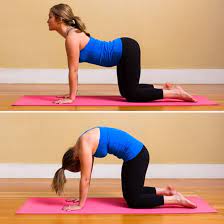
Passive backend:
First of all roll up a blanket, towel, or yoga mat.
The patient placed the roll on the ground.
When you utilize a yoga mat, you must want to roll only parts of it, depending on your middle back flexibility & the mat’s thickness, a bigger role needs more flexibility and a smaller one offers a more gentle release.
You are lying on the roll so that it relaxes against the bottom of your shoulder blades, close to the middle of your back.
When you use the yoga blocks for this backbend, place one block under your shoulder joint and a second block under your head.
Then elevate your head as much as required so that your neck feels supported, then stay comfortable in the posture and place a second blanket under your head like a pillow.
Maintain your breath long and deep.
Repeat this 3 times in 1 session and do 3 sessions each day.
Seated twist:
The patient’s position is sitting cross-legged if possible or in a chair.
Sit up tall and place my right hand behind you so that bringing one hand to your right knee joint, then try to slowly turn your heart to the right.
Lengthen through the spine and feel the twist wring out the tension in the middle of your back.
And start attention to the heart region and feel the back open.
Do not over-twist by pulling on your knee joint and twisting too aggressively, then try to gaze over your right shoulder joint only as far as your neck allows.
Maintain for 10 seconds and release to center.
Repeat this exercise 3 times in 1 session and do 3 sessions each day.
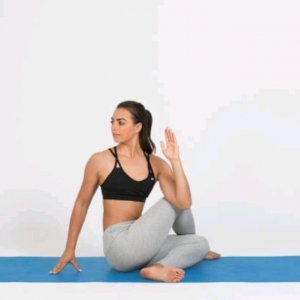
Cobra Pose:
The patient’s position lying on your stomach means a prone position, body long, chin on the mat, or face down.
Put your hands under your shoulder joint, and try to curl your chest off the floor and engage your middle back muscles.
Then raise the hands off the floor for a moment and engage through the middle back.
Try to push lightly into your hands to deepen the stretch.
Maintain for 10 seconds and release to center.
Repeat this exercise 3 times in 1 session and do 3 sessions each day.

Child’s pose
The patient’s position is starting in a kneeling position, with the hip joint and buttocks relaxing on the lower legs or feet, then extending the knee joint apart to a relaxing point.
Fold the body forward and bring the chest down towards the knee joint.
If possible bring the forehead to the ground with the arms stretched out in front.
The hands should be slowly resting on the ground and must be keeping the arms straight.
Keep for 10 breaths.
Repeat this exercise 3 times in 1 session and do 3 sessions each day.

Latissimus dorsi stretch:
The patient’s position is in a standing or sitting position.
Try to raise the right hand straight up, over the head, then flex the elbow joint, so that the right-hand drops toward the middle back.
Must place one hand on the right elbow joint and slowly pull the right arm to the left.
While pulling the right elbow joint and flex the body in a straight line to the left.
Make sure not to bend forward-backward.
Maintain this position for 10 seconds, and then repeat on the other side.
Repeat this exercise 3 times in 1 session and do 3 sessions each day.

Surgical treatment for middle back muscle pain
After the physiotherapy treatment and medical treatment pain is not reduced then the physician is suggested surgical treatment.
Surgery for middle back muscle pain is very infrequent.
Some conceivable surgeries for muscle pain involve:
Laminectomy: In this procedure removes the whole lamina and the back wall of a vertebra which de-stress the spinal cord.
Laminotomy: In this surgery removes a portion of the lamina which relieves a pinched nerve.
Diskectomy: In this procedure removes a portion of a spinal disk which relieves a pinched nerve.
Home remedies for this middle back pain
You are using it to ice the site and later use it to heat.
It is one of the most typical techniques which is provided quick relief.
You are taken to consider taking to over-the-counter pain drugs like ibuprofen (Advil) and naproxen (Aleve) to relieve the swelling and pain.
Stretch and strengthen the middle back muscles by accomplishing exercises like yoga.
You must be enhanced your posture release to middle back muscle pain.
Use some steps include to :
Must keep the shoulder joint back during the standing position.
Avoid slumping posture.
Take standing breaks if you sit for a long time.
If you do a desk job must be altering your chair and computer monitor height, keyboard and mouse positioning which is supplied to your good posture.
Prevention of middle back muscle pain
Adjust the sleeping position in everyday life because If you sleep on your back it is increased the chance of misaligning your spine which produces middle back pain.
There are some positions defined which are preventing you try this position:
- Try to sleep on the side with a pillow between your knee joints and sleep in the fetal position.
- Try to alter your posture
- Keep good posture which is to give your middle back muscles a break and allow them to strengthen.
- Your standing and sitting position must be straight for that lowering the chair height so that your feet stay flat on the floor then move the computer screens at eye level and use a standing desk for all strategies to improve the posture.
- If you feel weakness in muscles then contact a therapist which helps you for enhancing your core strength, posture, spinal mobility, and endurance.
- Always keep a healthy weight because being overweight and obese puts extra stress on the middle back muscles.
FAQ
When should worry about middle back pain?
Most back pain will decrease after a few days, but if you’ve been experiencing aches for over a week, then it’s time to call a doctor. Your doctor will conduct any analyses or tests needed to help get to the bottom of your pain before it could become a bigger problem.
What is the middle of your back muscle called?
Sacrospinalis
The sacrospinalis also called the erector spine is three muscles. They are the spinalis, iliocostalis, and longissimus. Each of these muscles is separated into three parts that correspond to the part of the back where they’re situated.
Will the muscular middle back ache go away?
Acute or short-time back pain stays a few days to a few weeks. Most low back pain is acute. It tends to determine on its own within a few days with self-care and there is no residual failure of function. In some cases, a few months are needed for the symptoms to disappear.
How long does a middle back muscle strain take time to heal?
Back muscle strains generally heal with time, many within a few days, and most within 3-4 weeks. Most patients with mild or moderate lumbar strains make full healing and are free of symptoms within days, weeks, or possibly months.
Does stretching help with middle back pain?
Regularly stretching the middle back can relax and strengthen muscles to help enhance posture and decrease back pain.
What causes tight mid-back muscles?
Chronic causes
Chronic tension: The most typical cause of mid-back pain is due to irritation or tension in the muscle and other soft tissue. Generally, this happens due to weakness, prolonged sitting, poor posture, or wearing a backpack. This can also be chronic overuse damage from repetitive movement.

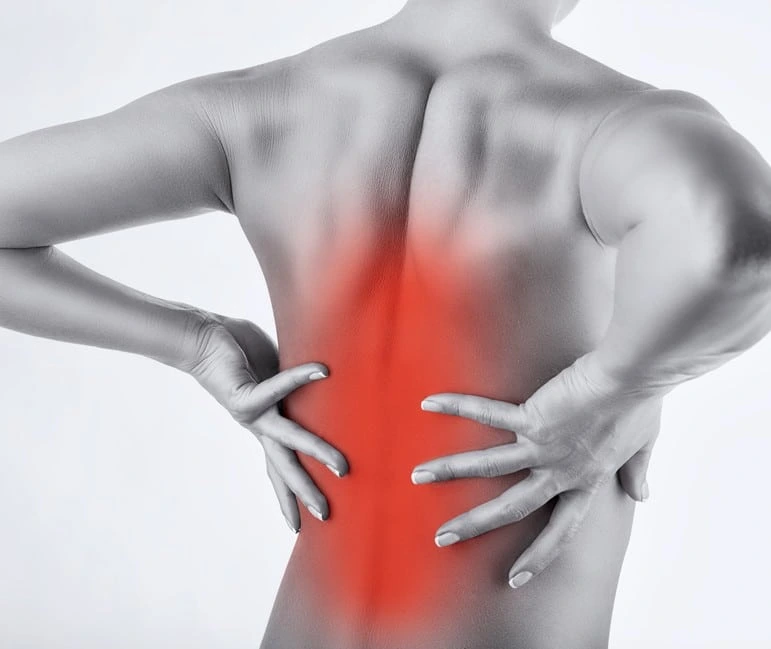
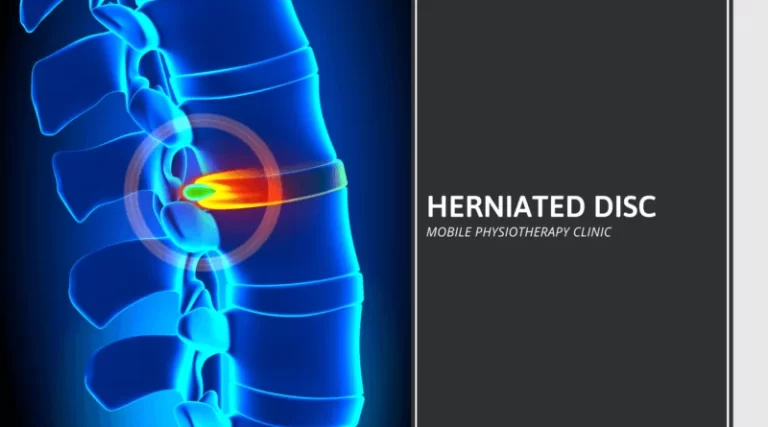
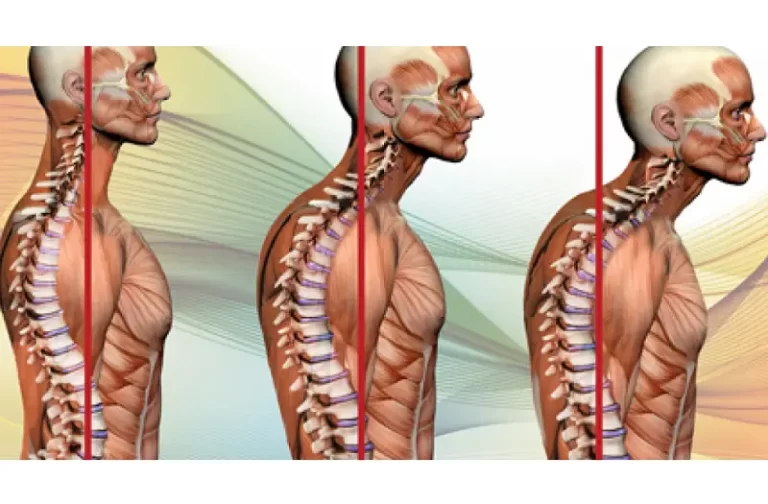

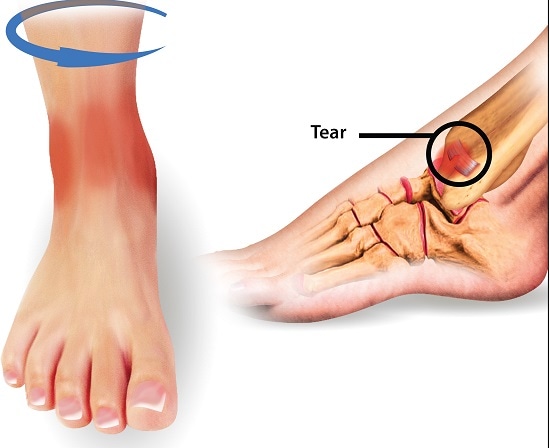

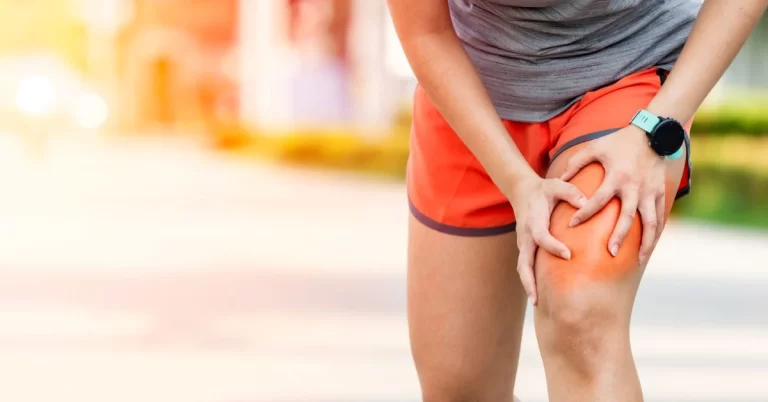
3 Comments